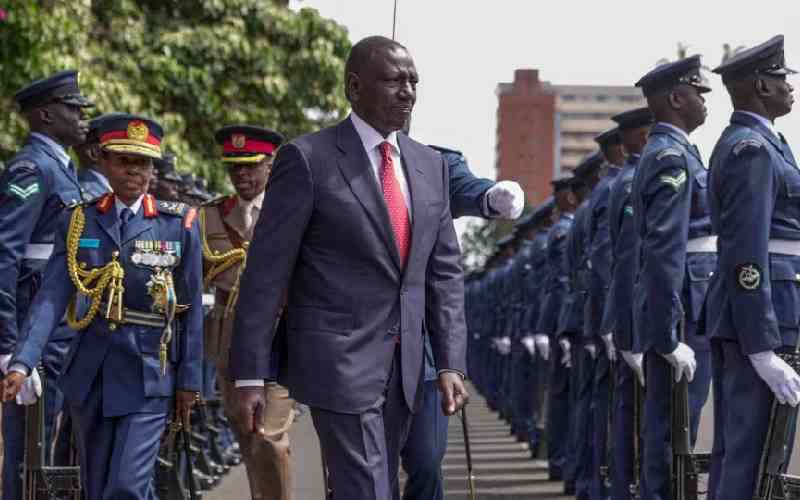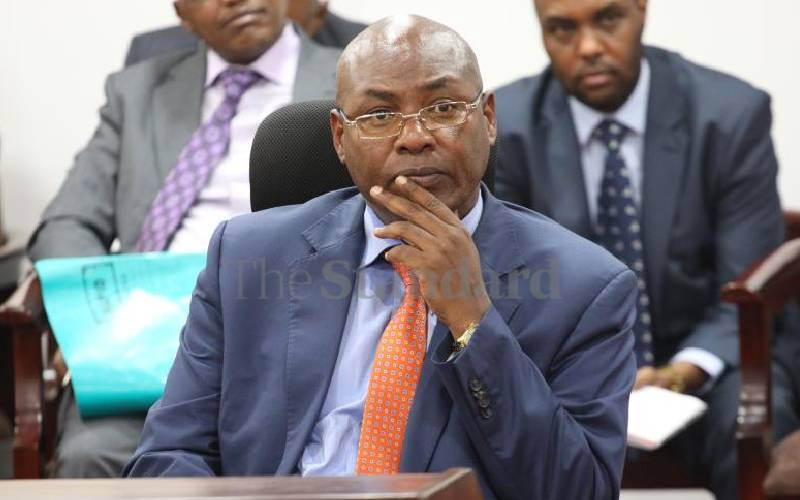Let’s now turn to the US$ 2 billion Eurobond issue in June 2014, since no one seems overly concerned with the fate of the November 2014 US$ 815.4 million issue; everyone seems happy all went well on this November fund raising. Here we are then, we’ve raised US$ 2 billion. What happened next? Our reading of the sequence of events is:
1. US$ 1.999 billion (i.e. US$ 2 billion minus fees and expenses payable to bankers, lawyers, regulators etc.) was transferred to an account opened by the Central Bank of Kenya on behalf of the National Treasury at JP Morgan Chase on June 30 2014 with the sole purpose of receiving the Eurobond proceeds. Questions which have arisen is why the account was opened at all, whether it was opened legally and why there was a delay in designating signatories. On the first: this is because it is customary to open Receiving Bank accounts for any Eurobond issues. This is the practice and I am afraid no one is going to change this practice to accommodate any Kenya-specific special need.
Ah, you may well ask: Kenya may have had to accept this market practice, but did Kenyan law allow it? Answer, contrary to the most recent writing on this question, is an unequivocal YES
Section 28 of the Public Finance Management Act states that “the National Treasury shall authorise the opening, operating and closing of bank accounts and sub-accounts for all national entities in accordance with regulations made under this Act”.
2. On July 3 2014 US$ 604 million was debited from this account at JP Morgan and used to retire the US$600 million syndicated loan (remember it?) plus interest. There has been debate about the legality of this action: was it authorised by the Controller of Budget? Was there legal authority to pay it out of the account at JP Morgan or should the loan have been paid out of the Consolidated Fund? The Controller of Budget and the National Treasury are best placed to answer these questions. But let’s not forget the essential and critical fact: Kenya owed this money, and Kenya had committed in the loan agreement to repay it from, among others, any Eurobond issuance; therefore, from a “was the US$ 604 million stolen” perspective the answer is an emphatic NO. This was a loan legitimately contracted and repayable.
A new element has recently been introduced into the Eurobond debate that, because JP Morgan had been fined nearly US$ 2 billion by the US authorities on money laundering charges, that bank is suspect, the insinuation being that it could have conspired with Kenyan officials to defraud Kenya. With due respect to the authors of this argument this doesn’t make sense. True, JP Morgan and whole host of other major international banks, the ones which dominate international trade and capital flows, have been fined heavily since the 2008 global financial crash for money laundering, sanctions breaking and financial markets’ manipulation.
3. Again on July 3 2014, US$ 395 million was transferred from the JP Morgan account directly to the Consolidated Fund, which resulted in a Kshs 34.6 billion credit to the Consolidated Fund. Why was this amount transferred and why on July 3? We have engaged the National Treasury on this and their answer is that there was a need to meet a Kshs 25 billion development expenditure amount invoiced for payment on June 30 2014, the last day of the Government’s financial year. And what happened to the other Sh9.6 billion (the aforementioned “missing” Kshs 10 billion)? After much throat clearing, the National Treasury have admitted that they “borrowed” this Kshs 9.6 billion from the development budget to meet urgent non-development budget expenses, also falling due on June 30 2014, but that the Kshs 9.6 billion was “repaid” to support the development budget in the 2014 / 2015 financial year.
4. So far, we have accounted for US$ 1 billion. Where on earth was the balance US$ 999 million all this time? Sitting pretty at the JP Morgan Chase Bank account until September 8 2014, when the entire amount was transferred to the Central Bank’s account at the Federal Reserve Bank of New York. And why was this amount lying at JP Morgan Chase Bank instead of being transferred to Kenya? Once more we have wrung an answer out of the National Treasury: they were determined to keep this amount segregated from the Government’s other funds for precisely the reason that its critics have been accusing the Government of NOT doing: that the funds were to be used only to finance for the development budget. Again it would need the Auditor General to determine why the funds could only be segregated offshore and not in Kenya. During this period up to September 8 2014, the funds at JP Morgan Chase Bank earned US$ 245,957 in interest revenue, and Kshs 2.4 billion in exchange gains, at a time when the US prime rate, the main borrowing rate in the USA was under 1 per cent.
One may agree or not with these actions; what concerns us is whether the money was stolen. What is clear is that no money was stolen at JP Morgan Chase, and that interest was earned while the money was there.
Another twist has been brought in; that the JP Morgan statements which support the National Treasury’s case were “redacted” statements, thereby lending an air of mystery as to what was being hidden. This conundrum is easily resolved: both the Auditor General and the EACC must insist on seeing the full statements, which the National Treasury, as the client of JP Morgan Chase, must have.
Yet another allegation is that because JP Morgan’s documents also mention other offices, then the Kenya Eurobond proceeds must have been routed to South Africa, or so it is alleged. I am not even sure how to start addressing this one. Why should any bank in its right mind send money to South Africa, whose currency is depreciating vis-à-vis the US$, thereby risking a certain exchange loss, only to bring this back to the US intact in US$?
5. On September 8, US$ 999 million was transferred to the Federal Reserve Bank of New York (the “New York Fed”). Once more lots of heat has been generated by this: how and why did this money end up at the New York Fed?
Some background is in order here. The US Central Bank is called the Federal Reserve System. It consists of a Board of Governors sitting in Washington, D.C., and 12 regional reserve banks, of which the Federal Reserve Bank of New York is by far the most crucial, since it sits alongside Wall Street, the world’s largest financial market. This federation structure is why the U.S. Central Bank is called the Federal Reserve SYSTEM.
Among many of the New York Fed’s functions is to act as banker to central banks. The New York Fed does not accept any other customer accounts other than from the banks it regulates and central banks. Since its foundation in the mid-1960s, the Central Bank of Kenya has had an account at the New York Fed, and that account is the Central Bank’s main US$ operating account, responsible for more than 60 per cent of all US$ activities by the Central Bank of Kenya. An example: whenever you read of the Central Bank having bought dollars from Kenyan banks, those dollars end up at its account at the New York Fed. Note that in the UK, the Central Bank of Kenya has similar accounts with the Bank of England for £ accounts and in Europe the Central Bank has € accounts with European Central Bank. Translated: central banks prefer having their main offshore accounts with other central banks
So why did the US$ 999 million end up in the New York Fed? Because the Central Bank of Kenya BOUGHT the US$ 999 million from the National Treasury and in return credited the National Treasury’s Kshs denominated Sovereign Bond account at the Central Bank with Kshs 88.46 billion. In other words, the US$ 999 million ceased being the property of the Kenya Government, through the National Treasury, on September 8. That is why the US$ 999 million “disappeared”; it was sold, and now belongs to the Central Bank of Kenya as part of our reserves.
Stay informed. Subscribe to our newsletter
6. The immediate key movements, which should now concern us are the debits from the Sovereign Bond Account to the Consolidated Fund. Why was the KShs 88.46 billion left in this Sovereign Bond account instead of being transferred to the Consolidated Fund? Again we have asked the National Treasury, and again have been advised that funds were released to the Consolidated Fund only upon request.
There are, of course, questions to be asked of the National Treasury, and we have set out some of these in this article. What we are confident about, though, is that Kenya received the entire US$ 2,815,000,000 minus the syndicated loan repayment and bond issuance expenses.
The is the Chairman of the Public Finance Sector Board of the Kenya Private Sector Alliance (KEPSA) and Chief Executive of Kenya Bankers Association
 The Standard Group Plc is a
multi-media organization with investments in media platforms spanning newspaper
print operations, television, radio broadcasting, digital and online services. The
Standard Group is recognized as a leading multi-media house in Kenya with a key
influence in matters of national and international interest.
The Standard Group Plc is a
multi-media organization with investments in media platforms spanning newspaper
print operations, television, radio broadcasting, digital and online services. The
Standard Group is recognized as a leading multi-media house in Kenya with a key
influence in matters of national and international interest.
 The Standard Group Plc is a
multi-media organization with investments in media platforms spanning newspaper
print operations, television, radio broadcasting, digital and online services. The
Standard Group is recognized as a leading multi-media house in Kenya with a key
influence in matters of national and international interest.
The Standard Group Plc is a
multi-media organization with investments in media platforms spanning newspaper
print operations, television, radio broadcasting, digital and online services. The
Standard Group is recognized as a leading multi-media house in Kenya with a key
influence in matters of national and international interest.








